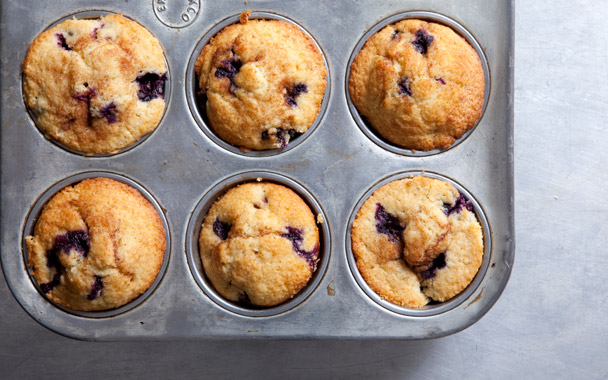August vacations in the White Mountains of New Hampshire, where wild blueberries grow right outside our screen door, have turned homemade blueberry muffins into a ritual. (My husband and I joke that both our daughters, now aged 20 and 17, have chronic cases of early-onset nostalgia. It first manifested itself around the age of 3, so that anything done once on vacation became an instant tradition the following year.)
Picking enough berries for muffins (1 1/2 cups) is faster than assembling enough for a pie (4 cups), but even so, the labor alone makes you reluctant to stir them into any old batter. Given the antioxidant powers crammed into those juicy little pellets, I was determined to make the surrounding cakey package live up to them nutritionally, beginning with whole-wheat flour.
What I specifically didn’t want, though, was for my intentions to be obvious. In other words, the end result couldn’t smack of 1970s hippie health food. A run-through with regular whole-wheat flour, however, produced just that: heavy belly-bombs that screamed “good-for-you.” Not at all what I had in mind.
When I discovered whole-wheat pastry flour, my attempts at whole-grain home baking dramatically improved. Whole-wheat pastry flour is the whole-grain version of pastry flour, which is made from soft wheat. Soft wheat has less protein, therefore less gluten, than the wheat used for all-purpose flour and a lot less than bread flour. Gluten, a good thing in yeast breads, is not so desirable in something you want to be tender, such as a muffin. I swapped whole-wheat pastry flour for regular all-purpose white flour in a standard muffin recipe, and I was amazed and delighted that it worked so well. The results were featherlight and tender, with a faintly nutty, wheaty taste.
Because whole-wheat pastry flour is paler than regular whole-wheat flour, the muffins even looked like the white flour ones spinning in the local diner case (in the end, that’s what any health-obsessed parent is up against), which is just what you want when you’re trying to pass off your homemade muffins as the norm. The true test? The girls’ picky-eater friends didn’t pause between their first and second muffins.
Tinkering is natural with something you make over and over, and my blueberry muffins haven’t been immune to the process. Over successive summers, I upped the butter, lowered the sugar, and added lemon zest and, later, a cinnamon sugar crust. It’s taken 20 years of tweaking but I’ve finally got my muffin recipe right where I want it.
Take Away Tip
Substituting whole-wheat pastry flour—cup for cup—for regular white all-purpose flour doesn’t work across the board in baking. Although I’ve had good results with drop biscuits and cobblers, rolled biscuits for strawberry shortcake were a total flop. Pie dough has also been disappointing; I need to try it again.




 Pinterest
Pinterest


